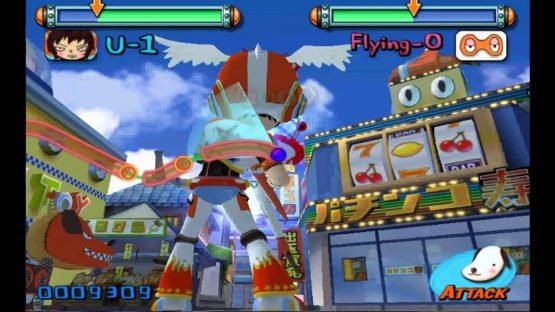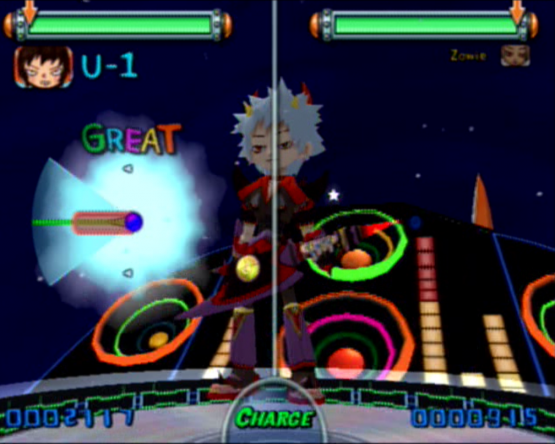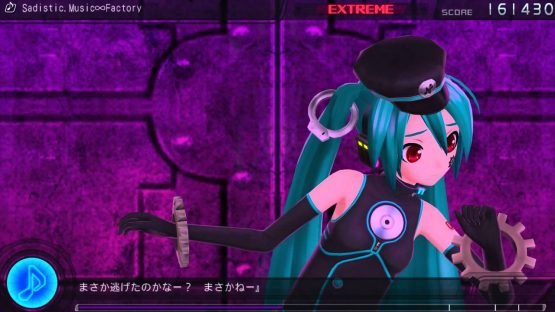Why Gitaroo Man is the Last Great Rhythm Action Game
Gitaroo Man is a really great game. Even 15 years after its release, it holds up splendidly. In fact, despite this amount of time to improve and innovate, I’ve yet to see another rhythm action game that can match its greatness.
I’ll admit that it sort of feels like a chunk of Gitaroo Man’s story is missing. It’s very fast-paced and very weird. But there is a story, and that alone makes it stand out from a lot of rhythm games. It’s a simple premise that does the trick in tying together all the individual levels. For those unfamiliar with Gitaroo Man, the basic idea is you are the chosen hero and you have to collect all the Gitaroos one by one by defeating a string of quirky bosses. Each level has its own musical style – centred around the guitar, naturally – so you’ll face off against a synth-based alien in a J-pop level or a trio of skeletons in a flamenco-inspired level and so on. The game really makes you appreciate the versatility of the guitar as an instrument, which is a beautiful thing for it to do.

After Gitaroo Man, something changed as far as rhythm games in the west – and, in particular, Japanese ones – go. The next game by the same creators, Osu! Tatakae! Ouendan, was not released outside of Japan, and Elite Beat Agents that came after used the concept of Osu! but altered it to be more suitable to a western audience. (I know part of the appeal of Osu! for me would be having songs from artists like L’arc En Ciel, who you can’t just replace with Avril Lavigne.) Even this though, is a completely different experience to Gitaroo Man, and one that many other excellent rhythm games, like the Hatsune Miku: Project Diva games, are perhaps more in keeping with, as it takes existing songs and puts them to levels, rather than having music created specifically for the game. In games like Project Diva and Final Fantasy: Theatrhythm, the appeal is the established music itself, so that makes sense, but it’s still a very different thing, compared to Gitaroo Man’s all-original soundtrack.

It’s an addictive game, and just as enjoyable the 10th time as the 1st. Maybe this is a matter of a clever gameplay ploy as far as Gitaroo Man is concerned, in that you can’t play individual levels. That’s not to say you can’t select which level you want to play, you can, but it automatically continues on from that song’s place in the story. That sounds kind of annoying, and I guess it is a little frustrating if you just want to switch from song to song, but it’s incredibly clever in that, if you’re anything like me, you just play through the story to get to the songs you want. For me, personally, this means starting at 6 or 7 levels in and just playing the whole rest of the game. I might just be easily pleased, but I’d say it’s got to be a pretty solid game for that not to get old.
Another obvious feature is that Gitaroo Man has a multiplayer mode. Admittedly, it’s very basic and probably do with a lot of improvements in that it seems to make vs matches supremely biased in one person’s favour, but who doesn’t want a music vs mode? Or a mode where you get to play the enemy’s part of a song? This makes Gitaroo Man one of the stand-out instances of Player 2 having a very enjoyable gameplay experience that is also totally different from that of Player 1, so that makes a change. (Technically, ICO has a 2-player mode in which the gameplay is very different for both players, but, seeing as player 2 can only really limp around and try not to die, it sort of fails on the first part.) They could probably have just given me a Villain Mode, rather than vs, but I appreciate both the ideas. (And I just said I would like to play through the same 10 songs AGAIN — if I got to do it from the other side… Wow.)

I’m not sure if there is a clear-cut difference, if any at all, that separates a ‘rhythm’ or ‘music’ game and a ‘rhythm action’ one, but Gitaroo Man is definitely worthy of the ‘action’ part. I guess as far as I’m concerned it’s about tension and a desire to progress. If you’re playing a JRPG (or, you know, an action game, more relevantly) and you get stuck on that one section of the game, it has a level of frustration to it that Gitaroo Man manages to replicate. Good frustration, of course (usually), but frustration nonetheless. I want to complete that level, I want to progress the story. Something like Project Diva doesn’t do that. Sure, there are definitely difficult levels, and every time you make a little more progress in one you feel satisfied, but if you lose then you just go and play a level you’re really good at to feel better about yourself (‘Like, Dislike’ or something) and then come back to it when you feel like it. It doesn’t matter.
As a child, I had to ask my step-brother to complete Gitaroo Man for me so I could actually practice anything beyond level 3. It became a goal for me to be able to play the game from start to finish myself, without having to reload and skip a level. I’d seen all the levels before, knew the story, had seen the ending of the game, but I wanted that success for myself. If I can’t do ‘Sadistic Music Factory’ on Extreme, so what? I don’t even like grapes ‘Sadistic Music Factory’ that much, and it’s not inhibiting my enjoyment of the rest of the game, so who cares? Maybe part of it is that the hardest levels of a rhythm game are usually at the end, which makes sense, whereas Gitaroo Man decided to do them from level 3 onwards. Most of the game is hard levels!

So what about the actual gameplay? Well, Gitaroo Man has a unique blend of attack and defence mechanics. While the ‘defending’ mechanic is nothing you haven’t seen before (different button prompts come in from the sides of the screen), Gitaroo Man also added an ‘attacking’ mechanic, which involved following a line around the screen and also timing and holding button presses to match the notes of the guitar. On top of these two core mechanics, the levels in Gitaroo Man are divided into different sections. These are really interesting, as they separate the attack and defence modes and force you to earn your own health bar in the Charge sections.
An impressive thing about this section-based level set-up is that there are multiple battle parts you can end up with. This is likely so that you can get another section if you haven’t whittled the enemy’s HP down enough to trigger the Final yet, but it also adds an element of luck. There was a while where there was only one of the Sanbone Trio member’s parts that I could actually do, so every time I had to retry the level (often) I also had to hope to get the one I could do. These variations slot seamlessly into the levels, which is a remarkable feat of composition, as far as I’m concerned.

Rhythm games saw a bit of a surge in popularity in the west with series like Guitar Hero and Rock Band. As fun as these games may be, I can’t detach them from the peripheral instrument controller gimmick. While many, if not all, are playable using an ordinary controller, that’s not the intention. Gitaroo Man managed to spice up the gameplay only using a simple PS2 controller. I’ve yet to find any rhythm game mechanic that quite lives up to the wibbly-wobbly attacking from Gitaroo Man. I think it’s something about the mixture of control as well as timing that makes it just a bit more interesting than standard button pressing. Many later rhythm games, especially for touch-screen platforms like the Vita, have incorporated slide notes, but none have broken the mould quite as well. Theatrhythm is probably the closest I can think of, the Field Mode levels certainly require control, but not button pressing at the same time.

I’m a huge fan of rhythm games, as is probably clear, and I’ve yet to play one that I don’t enjoy. I’m always pleased when a new one becomes available, and Hatsune Miku: Future Tone has enough content that it should keep me busy for a long while. To be honest, if I were recommending a rhythm game to someone, I’d probably suggest a Project Diva title (providing they don’t hate Vocaloid music), as it’s really everything someone is likely to want in a rhythm game. But, secretly, Gitaroo Man is still king.
- AeternoBlade II Out now on Switch and PS4 - October 11, 2019
- Code: Realize Future Blessings Comes to Switch Spring 2020 - October 3, 2019
- Code Vein Out Now, Launch Trailer Released - September 27, 2019





